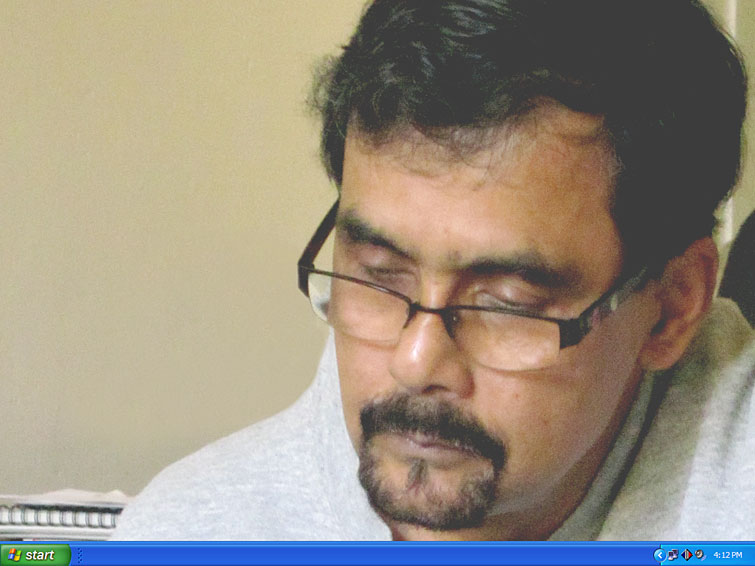About
Introduction to the content and goals of this site.

Needless to say, it is the socialization aspect of thek that is at the core of this site; and in this context, it is integral to another word: adda. Unlike thek, adda is a uniquely Bengali concept (why this is so is a matter of a complex anthropological inquiry, beyond the purview of this introduction). Not precisely translatable, it loosely signifies a kind of informal chit-chat. An adda has no predetermined topics, no apparent logic of progression, purpose or time limit; conversations change course arbitrarily, seemingly unrelated topics come and go and time seems to halt in a perpetual present. Often sporadic, adda can happen virtually at any place; but if the same individuals frequent a specific place with some regularity (everyday, every weekend, once in a while) for adda, then that place qualifies as a thek. In short, a thek is a recognized venue for adda. It can be a bar, a clubhouse, a living-room, a porch, even a street-corner; but most preferably, it’s a tea-stall or a coffee-house, primarily because tea or coffee (along with cigarettes, for some) is indispensable for most addas. Especially prevalent among Bengali youth, the practice of adda isn’t age-specific, though it is common for the patrons of a thek to belong to a particular age-group.
What does one achieve from going to a thek for adda? Except that it helps one to relax (which is an overused argument, anyway), I don’t believe any Bengali knows a reasonable answer to this question; yet most would instinctively accept an invitation to an adda. Too much investment in adda is often criticized as unproductive idling, which it indeed is. And yet, historically, immensely productive adda isn’t an oxymoron at all. The famous thek of the Calcutta Coffee House on Kolkata’s College Street is a case in point. Writers, artists, filmmakers, activists (especially of the leftist ilk) and the like have gathered there for generations, and some of the most notable contributions in those fields have germinated in the vibrant exchanges, discussions and debates held there day after day, for years. Therefore, no matter how bizarre it sounds, it wouldn’t be an overstatement to say that adda is a crucial component of Bengali cultural discourse.
In light of this discursive role of adda, its gender dynamic at an outdoor thek must be mentioned. Until the last decade or two, with the exception of a handful of venues like the Calcutta Coffee House and college cafeterias (called “canteens’ in India), an outdoor thek had been frequented almost exclusively by males. When my generation was young, for a young female to sit in a roadside tea-stall and chat with her male friends was to raise a whole lot of eyebrows. Those days are all but hazy memories, at least in a big city like Kolkata, and that’s good news indeed.
I have lived abroad since the late 1980s, but have always resumed adda at familiar as well as new theks on my repeated visits to Kolkata. Therefore, soon after I considered having my own space on the Internet, the concept of thek provided the primary impetus to make my space both personal and public. So here it is. Grounded in a bit of nostalgia, this site is a virtual thek devoted to adda on visual culture. Yet it differs from the conventional thek because it has a sense of purpose: it aspires to promote critical understanding of visual culture. I envisage it as a productive platform where artists, art writers and the like anywhere on the planet can make new contacts and share a diverse range of ideas.
One part of the site has my personal stuff: my essays and other writings, images, and blog; while the other part is open to friends, acquaintances, even strangers. Artists are invited to offer their images for display in the “Gallery”, along with their vitae and contact information. They can also advertise their exhibitions or other efforts in the “News” section. All this is completely free of charge (though, if participation swells in the future, the site’s maintenance may require a nominal one-time uploading fee, just like people at an adda often chip in for tea or snacks). Any party interested in someone’s art should contact the artist directly, since I am not interested in financially profiting from such transactions (this policy will never change). Art writers are welcome to contribute essays and reports, and anyone is free to propose topics to the “Forum” for fruitful dialogs. And of course, all are expected to provide feedback on my ongoing effort to upgrade and improve the site. At the moment, it can be regarded as a social networking site only in a severely limited sense, as there are obvious constraints of its technology and specificity of its purpose. Only time will tell how it evolves.
So, welcome to globalthek!
Sunanda K Sanyal
Curriculum Vitae

Sunanda K Sanyal
Education:•2000: Doctorate of Philosophy in Art History, Emory University. Title of dissertation: Imaging Art, Making History: Two Generations of Makerere Artists. Employment: Professor, Art History & Critical Studies, College of Art and Design, Lesley University Research interests:Politics of representation and identity; representation and otherness; contemporary artists from former colonies in global discourses. |
